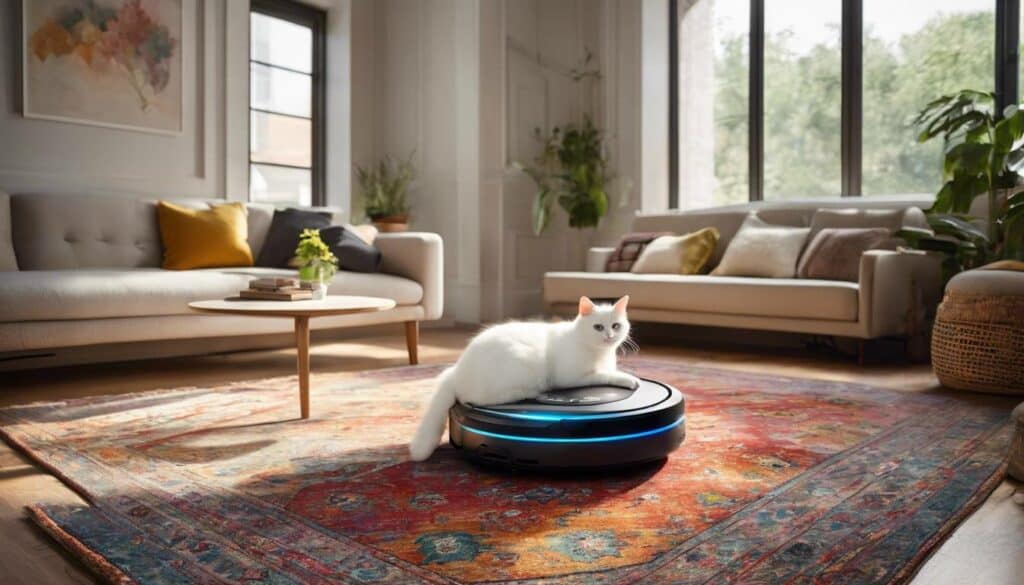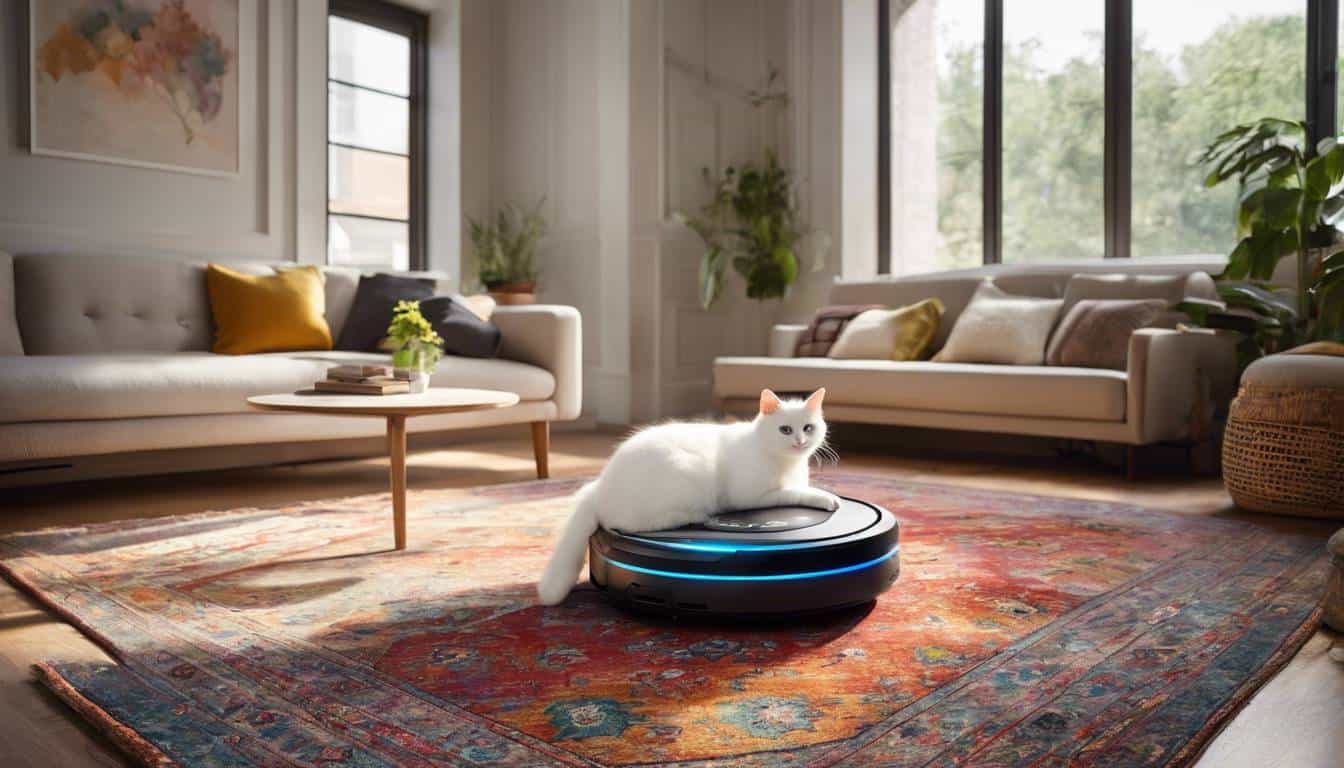I discovered that keeping my floors clean after a hectic day was quite a challenge. The last thing I wanted to do was clean, but having pets meant it was a regular occurrence. That’s why I developed a quick and efficient cleaning routine to ensure my floors stay lustrous without taking up too much time. I even learned how to deep clean laminate floors effectively when needed.
Break down the task into small parts and use a timer for short bouts of cleaning before resting. This method mitigates tiredness and ensures your spaces get cleaned. Beyond that, choose multi-use cleaners and consider investing in tools like robot vacuums or spray mops. These minimize effort and transform your cleaning routine. Now let’s dive into the process.
One effective strategy is to break the cleaning process into smaller, manageable tasks and spread them out throughout the day. For example, spending 10 minutes in the morning and 10 minutes in the evening doing some cleaning can help maintain a tidy home even when feeling fatigued. This approach is particularly useful when dealing with sticky laminate floors, which can be a common issue in busy households. Additionally, considering the use of helpful apps like “Sweepy” to schedule and track chores can make cleaning more manageable during low-energy periods.
Starting the Cleaning Process
When facing cleaning tasks with low energy levels, having a plan is crucial. It serves as the foundation of efficient and effective cleaning. Take a moment to assess each area and make a mental note of what needs attention. Visualizing and organizing your approach can help reduce stress and prevent feeling overwhelmed.
Breaking down the cleaning tasks: To avoid the daunting feeling of having to tackle everything at once, break down the cleaning tasks into smaller, manageable chunks. Start with high-traffic areas or spots that look more visibly dirty. By creating a mental or physical checklist of specific areas to focus on, you can work through them one by one, giving yourself a sense of accomplishment as each task is completed.
Setting a timer for short bursts: Use a timer to schedule short bursts of cleaning, followed by rest periods. This technique, often referred to as the “Pomodoro Technique,” helps break down tasks into more manageable intervals and avoids burnout. For example, set a timer for 10-15 minutes of focused cleaning followed by a 5-minute break. This cycle allows you to maintain productivity without exhausting yourself.
For instance, start by setting the timer for 15 minutes and focus solely on sweeping or vacuuming one room. Once the timer goes off, take a 5-minute break to rest and recharge before moving on to the next task. This allows you to maintain steady progress without overwhelming yourself.
Addressing one room at a time can also be beneficial in preventing fatigue. Focus on completing each room before moving on to the next. It gives you a sense of achievement as you finish a designated space, making it easier to track your progress.
By implementing these tactics, starting the cleaning process becomes less daunting, allowing you to work through the task efficiently without exhausting yourself further.
Remember, for more tips and hacks on efficient floor cleaning when low on energy, head over to our website at “Amazing Home Decor Co.”
Recommended Cleaning Products
When it comes to keeping your floors clean, having the right cleaning products can make all the difference. Imagine a magic potion that makes dirt disappear with just a wave of a mop—well, we’re not far off from that! Here are some of the top-notch cleaning products that can help you keep your floors spotless with minimal effort.
Multipurpose Cleaners
Investing in a good multipurpose cleaner can be a game-changer. Instead of juggling different bottles and sprays for different surfaces, a multipurpose cleaner allows you to streamline your cleaning process by using one product for multiple surfaces. This not only saves time but also reduces the number of products you need to store and keep track of. Look for a cleaner that’s safe for the specific types of flooring you have, whether it’s hardwood, tile, laminate, or vinyl.
Robotic Vacuums
If you want to take the physical effort out of the equation entirely, robotic vacuums are a fantastic investment. These little gadgets zip around your home picking up dirt and debris without any manual intervention. Some models even have mopping capabilities, making them an excellent choice for maintaining hard floors. With scheduled cleaning sessions, they keep your floors clean without you having to lift a finger.
Spray Mops
When it comes to actual floor cleaning, spray mops are another low-effort tool worth considering. These mops come with a built-in spray mechanism that allows you to dispense the right amount of cleaning solution as you mop, eliminating the need for a separate bucket and wringing out excess water. They are easy to maneuver, generally lightweight, and can make floor cleaning less physically demanding.
Natural Cleaning Solutions
For those who prefer natural options, there are plenty of eco-friendly cleaning products readily available. Many natural cleaners use plant-based ingredients and essential oils to effectively clean floors without introducing harsh chemicals into your living space. These products can not only make your cleaning routine more environmentally friendly but also ensure that your floors are safe for children and pets to play on.
So, whether it’s an all-purpose cleaner, a robotic vacuum, a spray mop, or a natural cleaning solution, each of these products offers its unique set of advantages in making your floor cleaning routine less physically demanding and more efficient.
Whether you’re dealing with hardwood, tile, laminate, or vinyl flooring, having these products on hand can turn tired floor-cleaning days into quick and effortless tasks.
And for more information on recommended low-effort cleaning tools and products like these, don’t forget to visit amazinghomedecorco.com.
Step By Step Process for Quick Cleaning
Imagine returning home after a long day, feeling tired, but knowing that your floors need some attention. You don’t want to spend hours cleaning—just a quick tidy up is what you’re looking for. The key here is efficiency. Let’s break it down into simple, manageable steps:
Step 1: Tidying Up Clutter
Before you start cleaning your floors, it’s important to tidy up loose items like shoes, toys, and other belongings that might be lying around. This not only makes the cleaning process easier but also ensures that nothing gets in your way as you move around.
Step 2: Spot-Cleaning Visible Areas
Now that things are tidied up, focus on areas that need immediate attention. Use a handheld vacuum or a sweeping brush to quickly remove visible dust, crumbs, or dirt from high-traffic regions such as the doorway and kitchen areas. This spot-cleaning can make a noticeable difference in a short amount of time.
Step 3: Focusing on High-Traffic Zones
Areas that see a lot of foot traffic tend to accumulate dirt and grime more quickly than other parts of the house. Instead of cleaning the entire floor, direct your attention to these specific zones. A quick sweep or mop of these areas can give the appearance of an overall cleaner home.
By prioritizing high-traffic zones, you’re making smart use of your time and effort. It’s like focusing on the heart of the matter without getting lost in less important details—efficient and effective.
Having streamlined the cleaning process by removing clutter, spot-cleaning visible areas, and focusing on high-traffic zones, let’s delve deeper into how to utilize time-saving tools for a quick and efficient clean.
Maximizing Energy and Effort
Cleaning the floor can be exhausting, but with the right tools and mindset, you can make it more manageable. Consider using ergonomic cleaning tools like lightweight vacuum cleaners and long-handled mops. These allow you to clean without straining your body too much. And don’t forget about spray bottles with adjustable nozzles – they can help minimize physical strain by allowing you to adjust the spray to match your needs.
When your cleaning tools are comfortable to use, you’ll find yourself less tired and achy after each cleaning session. It’s like using a bike with the right seat height – it’s easier on your body, right? So, investing in floor-cleaning tools that suit your body will really pay off.
Here are a few ergonomic cleaning tools and methods for maximizing energy and effort:
Ergonomic Cleaning Tools
Tool |
Benefit |
|---|---|
Lightweight Vacuum Cleaners |
Easier to maneuver around the house and won’t tire you out as quickly. |
Long-handled Mops |
Allow you to clean floors without bending over too much, reducing strain on your back. |
Spray Bottles with Adjustable Nozzles |
Give you control over the spray power, reducing the effort needed to apply cleaning solutions. |
These tools are like great support characters in a video game; they make it easier for you to go through the levels of floor cleaning without facing as many obstacles along the way.
Let’s look at lightweight vacuum cleaners. Imagine them as friendly little robots that can zip around your home effortlessly, picking up crumbs and dust without causing you any back pain. It’s amazing how something so simple can make such a big difference in maintaining your floors.
Moreover, maximizing energy isn’t just about using the right tools – it’s also about finding ways to keep yourself motivated while tackling this chore. Consider listening to energizing music or engaging podcasts; this can turn floor cleaning into something more enjoyable. It adds a little pep to your movements, making the task feel less like a chore.
Consider playing energizing music or podcasts to boost motivation while cleaning.
So, by utilizing ergonomic tools and bringing some good vibes into play, you’ll find that keeping your floors clean becomes a much lighter and more enjoyable task.
Simplest Floor Cleansing Methods
When fatigued, quick and efficient cleaning methods become essential. Below are simple yet effective techniques to maintain pristine floors without expending too much energy:
Quick Spot Cleaning with Baby Wipes
Baby wipes are not just for babies! They can be a lifesaver when it comes to swift and efficient spot cleaning. With their gentle yet effective cleaning properties, baby wipes can easily tackle small stains or spills on hard floors without the need for water or additional cleaning solutions.
They are particularly handy for pet owners dealing with small mishaps such as paw prints or minor accidents. Moreover, their portability allows you to address minor messes swiftly, without the hassle of setting up traditional cleaning supplies.
Specialized Floor Wipes
Specialized floor wipes are specifically designed to provide a quick and efficient cleaning solution for various types of hard floors. These pre-moistened wipes often feature specialized formulations to dissolve tough dirt and grime, making them an ideal choice for tired individuals seeking a convenient and effective way to maintain their floors. They’re particularly useful for cleaning floor grout without scrubbing, which can be a tedious task. These pre-moistened wipes often feature specialized formulations to dissolve tough dirt and grime, making them an ideal choice for tired individuals seeking a convenient and effective way to maintain their floors.
They are particularly effective for laminate, vinyl, and tile floors, offering a convenient way to perform routine touch-ups without the need for mops or buckets. By incorporating these specialized wipes into your cleaning routine, you can maintain a tidy living space even during times of fatigue or low energy.
Self-Cleaning Litter Boxes for Pet Owners
For pet owners, investing in a self-cleaning litter box can significantly alleviate one major cleaning chore from the daily list. These innovative devices are designed to automatically remove waste, providing a convenient solution for individuals who may be too tired or busy to clean their pet’s litter box regularly.
By delegating this task to a self-cleaning system, pet owners can minimize odor and maintain a cleaner living environment without the need for frequent manual scooping. This can be especially beneficial during periods of fatigue or when juggling other responsibilities, ensuring that the floor around the litter box remains tidy with minimal effort.
Incorporating these simple cleaning techniques into your routine can make maintaining clean floors more accessible, even on days when you’re feeling tired.
Now, let’s explore how adopting these quick floor cleaning practices can grant you some well-deserved breaks while keeping your space tidy.
Taking Breaks with a Clean Floor
You’ve just finished cleaning your floors, and they look amazing. Now it’s time to sit down, take a deep breath, and acknowledge the hard work you’ve put in. It’s important to recognize the achievement of completing a task and appreciate the transformation you’ve made in your living space.
Imagine walking into a room with freshly cleaned floors—everything is sparkling, there’s a fresh scent in the air, and the whole area feels rejuvenated. Taking a moment to enjoy the fruits of your labor not only allows you to appreciate the cleanliness but also contributes to creating a sense of calm and satisfaction in your home.
After completing a cleaning task, take a break and appreciate the immediate results of your efforts. This can provide a sense of accomplishment and motivation to continue. A clean home can contribute to a more relaxed and stress-free environment.
Moreover, taking a break serves as an important self-care practice. It’s an opportunity to reward yourself for the hard work you’ve done. Congratulate yourself for making progress towards a cleaner, more organized living space, and remind yourself that it’s okay to take things one step at a time.
It’s not just about physical relaxation; it’s also about mental rejuvenation. By providing yourself with moments of rest and gratification, you’re promoting a positive mindset and reinforcing the idea that your efforts are worthwhile.
The Science Behind It
Researchers have found that taking breaks can improve productivity and overall well-being. When you pause to appreciate your accomplishments, it triggers positive emotions and motivates you to continue with other tasks. This encouragement is essential for maintaining momentum in household chores like cleaning.
Imagine this: You’ve just scrubbed your kitchen floor until it shines. As you admire its gleaming surface, you feel a sense of pride and contentment wash over you. This feeling helps renew your energy and prepares you to tackle any remaining tasks with enthusiasm.
You might even find yourself dancing around your freshly-cleaned room—a little victory dance perhaps? Celebrating those small wins is an essential part of staying motivated while keeping your home clean.
So, by taking breaks after cleaning and relishing in the immediate results, you’re not just rewarding yourself; you’re setting the stage for continued motivation and cultivating a serene, stress-free living environment.
With these efficient floor cleaning tips in mind, let’s now shift our focus to another aspect of maintaining a tidy household—strategies for achieving long-term cleanliness that will reduce the frequency of intense cleaning sessions.
Final Thoughts on Efficient Floor Cleaning
By now, we’ve discussed an array of floor-cleaning strategies and tools aimed at minimizing fatigue and maximizing efficiency. Now, let’s reflect on the key takeaways from our discussion.
Efficient floor cleaning is more than just a series of activities; it’s about adopting a mindset that values smart, time-saving habits and utilizing the right tools for the job. By incorporating low-effort cleaning tools, such as lightweight mops and ergonomic vacuum cleaners, it becomes easier to maintain your living space without overexerting yourself.
Remember, it’s not just about getting the job done quickly; it’s about doing it in a way that minimizes physical strain and maximizes results. This means paying attention to posture, taking breaks when needed, and using tools that reduce the amount of bending, reaching, and lifting required during cleaning tasks.
Think of it like this: just as a chef uses the appropriate kitchen tools to make cooking more efficient and enjoyable, choosing the right floor-cleaning tools can make the chore less burdensome and even somewhat satisfying.
For instance, if you find sweeping physically straining or time-consuming, investing in a robotic vacuum cleaner to handle quick touch-ups throughout the week can significantly reduce your workload. This way, when you do your weekly deep clean, you’ll be starting from a much cleaner baseline.
The Importance of Smart Habits
Efficiency in floor cleaning also stems from forming smart habits. Making it a habit to tidy as you go and addressing small messes promptly can prevent dirt and grime from building up excessively. This not only reduces the burden during weekly cleanings but also maintains a tidier living environment overall.
In conclusion, embracing efficient floor cleaning practices not only makes the chore less taxing but also ensures that your living space stays consistently neat with minimal effort. With the right tools and strategies in place, you can maintain a clean home without feeling physically drained—making it easier to strike a healthy balance between upkeep and relaxation.






